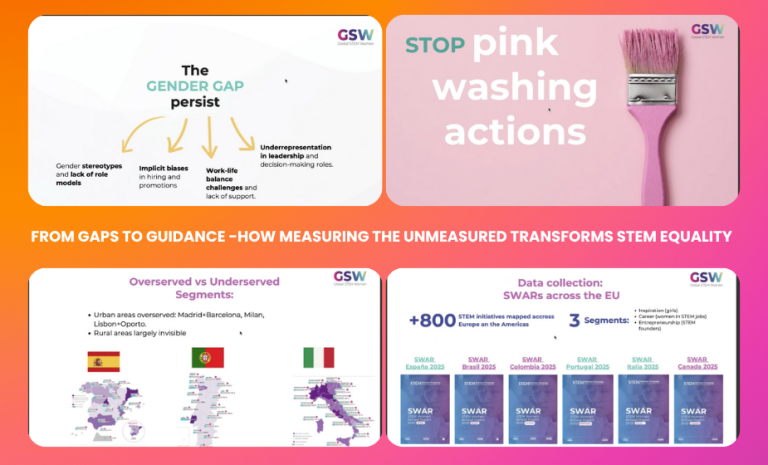Webinar: From Gaps to Guidance - How Measuring The Unmeasured Transforms STEM Equality
On October 22 2025, Connecting Women in Digital, together with Global STEM Women and the STEM Women Congress, hosted the webinar “From Gaps to Guidance: How Measuring the Unmeasured Transforms STEM Equality”.
Moderated by Brendan Rowan (BlueSpecs / Connecting Women in Digital), the session explored how systematic data collection and shared metrics can turn scattered actions into measurable impact.
Rowan opened by restating the initiative’s core mission, to bring more women into digital roles and help them thrive, and by presenting its three pillars: the forthcoming Women in Digital Index, the Women Digital Forum and the Women Digital Summit, each fostering progress through data, dialogue and collaboration.
Mapping initiatives, spotting what works and what doesn’t
The webinar’s keynote speaker Eva Díaz, journalist and founder of Global STEM Women and STEM Women Congress, described a seven-year effort to map and assess programmes that promote women and girls in STEM. Her team has identified and mapped over 800 initiatives across multiple countries and built a digital platform, the STEM Atlas, to register and track them.
The Congress now operates in seven countries (Spain, Portugal, Italy, Canada, Colombia, Brazil and Ecuador) producing national reports that reveal common trends and country specific insights, the STEM Women Annual Report.
Díaz explained that the project began with a simple question: if so many initiatives exist, why does progress remain limited? She attributed the gap to duplication, weak coordination and what she called “pink-washing”: campaigns that create visibility without impact. The STEM Atlas responds with consistent classification, unique IDs and shared KPIs to make outcomes comparable over time and to create a predictive model.
Hard facts: base, funnel and conversion
Díaz framed the problem using a funnel metaphor borrowed from marketing: to increase the number of women in STEM careers, outreach at the base must reach far more girls. In Spain, around 150,000 children took part in STEM activities last year, only 2% of the 0–16 population. Expanding this base is essential to sustain future growth.
The Congress is developing conversion factors by linking programme data to national enrolment statistics and tracking longitudinal indicators. Differences in national data cycles and legal limits on monitoring minors make this complex, yet the effort is refining a model that countries can adapt.
What works: inspiration, presence, role models and confidence
Beyond numbers, the discussion then focused on human factors. Self-confidence, inspiration, visible role models and a sense of community emerged as key drivers of persistence. Around 30% of women leave STEM studies during the first two years of university, often due to isolation. Mentoring, visible female role models and alumni communities are practical, replicable interventions that help address this retention challenge and promote STEM.
An inspiring example is the STEM Tour, a mobile outreach campaign that covered 3000 km, visited seven regions and reached 1250 children in rural schools, showing how direct encounters with women engineers can spark ambition and belonging.
Data, inclusion and policy implications
The webinar debate also addressed the complexity of intersectional data. Díaz noted that North American datasets often include race or ethnicity to reveal “minorities within minorities,” while European systems focus on privacy. Participants agreed that harmonised, gender disaggregated datasets and shared indicators would help shape stronger and policies based on evidence while acknowledging legal and cultural constraints.
Standardised measurement can expose territorial gaps, guide targeted funding and help institutions evaluate real outcomes. Díaz suggested that universities and training centres include a simple question in enrolment forms, such as whether students joined a STEM outreach activity, to build more accurate longitudinal evidence.
Closing
The concluding segment of the webinar featured a lively Q&A session with attendees. Asked how she would invest a €1 million fund, Díaz replied without hesitation: in actions that build girls’ self-confidence and open visible pathways into STEM. Confidence, she said, is the factor that most clearly translates inspiration into persistence.
The session ended with a call to collaborate. The STEM Women Congress Annual Report and the STEM Atlas remain open resources for researchers, policymakers and organisations committed to using data to measure progress and to drive it.




